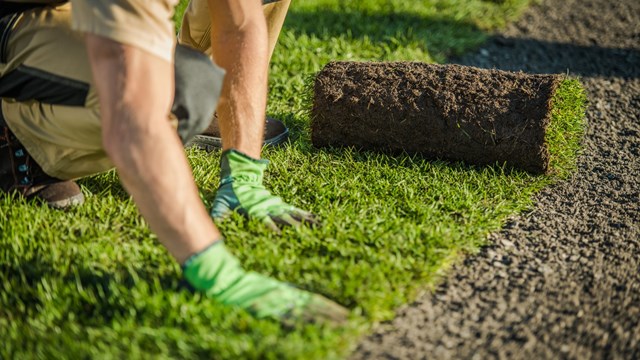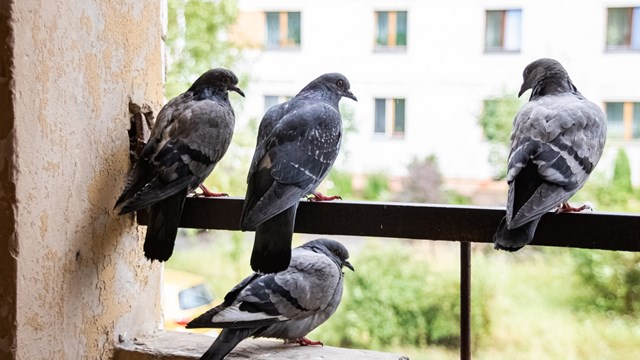It's an inescapable truth: there's no such thing as a prosperous, attractive community with unkempt landscaping. Value and beauty go hand in hand and that premise is true for homeowner associations, too. At the very least, residents want green lawns and healthy trees, and beyond that, they usually insist on attractive bushes and shrubbery, as well as blooming plants.
At the same time, however, they want to keep costs as low as possible, and those sometimes-conflicting demands can result in landscaping programs that as attractive as it could be—may also be somewhat unsafe. The problem is often compounded by the association and board members' skittishness when it comes to the cost of using organic or environmentally-safe materials and the "if it's not broken, don't fix it" approach to landscaping maintenance.
But there is a middle ground; your association can minimize the impact on the environment while still achieving the lush greenery and brilliant flowers association members have come to expect.
Dollars and Seeds
Balance doesn't come just for the asking, however. According to the Environmental Protection Agency (EPA)'s website, yard waste is second only to paper when it comes to the millions of tons of solid waste in municipal landfills. Landscaping the right way can reduce this, but it takes some effort on the part of the association or building management—and occasionally some additional expense.
"All of the tenets of proper landscaping in a single-family home situation should also be applied to huge condominium complexes and townhome developments," says Barbara Bromley, a horticulturist for Mercer County.
That's easier said than done, however. It's easy for a single-family homeowner to decide how their lawn should be cared for in a manner that best fits his or her family's need. With as many as a hundred or more families sharing common grounds, it's harder—if not impossible—to suit each individual resident's needs and desires.
Very few condo and co-op developments make a special point of insisting on environmentally-safe landscaping programs for a simple reason: Money. It's partly to do with the fact that organic materials cost more, but the real problems are that associations usually go with the lowest bid from landscaping companies and aren't involved much at all with what that company does after the fact. As long as things look good, people tend to be happy—or at least content enough that they don't say anything.
Gaining a better understanding of what your landscaper is doing is the best way to know how your lawns, plants and trees are being treated. It's also a good way to keep costs down.
"You should get a list of products your landscaper intends to apply, and then do some research," says Mark Klama of Lawnworks in Florence, a company with an organic program. "It does require some work. Then you have to monitor them when they are there to make sure they are applying what they said they would—because the natural products tend to be a lot more expensive than synthetic products."
Others feel the association's responsibility goes even farther.
"First of all, HOAs need to have someone on the association's landscaping committee who understands horticulture," says Bromley. "If you put seven bankers on the committee, they may or may not have any past experience with pruning bushes or planting lawns"
According to Bromley, problems often begin when landscaping plans are poorly designed from the beginning, sometimes before the development is even built.
"Sometimes the plants that are chosen are inappropriate," Bromley says. "Or they're planted in places they shouldn't be. One of the problems I've run into with associations is that when something dies, they'll just say, oh, [the designer] put an azalea at the base of a downspout, so we'll just put another one there. That's insanity."
Ironically enough, condo and co-op units are the very places where cautious landscaping is most needed. With so many people living in one area, odds are that there's someone living there with allergies, or children and pets playing and walking and playing all over the property.
One possible solution to that, says Richard Obal, an agriculture agent with Rutgers University Cooperative Research and Extension, may be what's called Integrated Pest Management, or IPM.
"The goal of an IPM program is to use monitoring, cultural, biological and chemical control strategies to manage pests populations and not necessarily to eradicate the pests entirely."
"While the IPM program may use chemicals to control pests," says Obal, "the rate and frequency of application is often reduced, compared to conventional chemical control programs. It's done in a much more environmentally sensitive way."
According to Obal, IPM got its start in large-scale commercial agriculture, but it quickly rose in popularity and is now the recommended method for pest control on any scale—large or small.
"People should monitor their landscaping, and stop and think if a pesticide is even needed," Obal continues. "Instead of coming in and spraying on a regular basis, IPM landscaping firms come and monitor your plants to see if the pests are actually there. We're not shooting with a shotgun. We want to check first."
If there is a pest problem, says Obal, there are various things that can be done before resorting to toxic sprays. Sometimes getting rid of pests is as simple as examining the conditions they're thriving in. Some insects may attack a plant in a location that's too shady, or a plant may have a disease because of poor drainage, or bad soil conditions. IPM looks at all the interlocking factors behind a plant's failure to thrive, and applies the most appropriate remedies—which often don't include harsh pesticides.
Environmental Concerns
According to the EPA, there are nine main concerns when it comes to environmentally friendly landscaping practices:
Put the right plant in the right place. If you're planning an environmentally-conscious landscaping program, the plants you choose for your association should require minimal amounts of water, fertilizer and pesticides, resulting in a sustainable landscape which will save you time, energy and money while limiting the impact on the surrounding environment.
Keep things water-efficient.You should water and/or irrigate only when your landscape needs it; proper watering insures that your shrubs, trees, and other plantings don't get waterlogged and reduces runoff that can contribute to erosion and chemical displacement.
Know How to Mulch Properly.Maintaining a two- to three-inch-thick layer of organic mulch (such as straw or bark chips) around trees, shrubs, and flowerbeds will help retain moisture in the soil, prevent erosion, suppress pesky weeds, and create a perimeter for your in-house groundskeeping staff to mow around, preventing damage to tree trunks and low-growing foliage. Remember to keep mulch one to two inches away from stems and trunks to prevent too much moisture from causing stem rot.
"One of the first things you want to do is keep the newly developing tree roots from competing with the grass that's near it," says Bromley. "The next thing you want to do is prevent mower blight, which is when a mower gets too close to the trunk of a tree and bashes it. So by putting mulch at the base of a tree - say three feet out from the trunk in a big circle—you avoid those kinds of problems."
Bromley concurs with the EPA on the issue of mulching too close to the trunks or stems of growing plants. Simply dumping the mulch by a tree or on plants results in what Bromley calls a "mini-mulch volcano."
Recycle. You can easily recycle grass clippings, leaves, and yard waste into mulch or compost on-site, and use it around trees, shrubs, and plantings. This saves time and money and reduces the amount of yard waste that has to be disposed of.
Fertilize Properly.If your association grounds staff does its own fertilizing, make sure instructions are followed to the letter, and remember that less is often better than more. Over-fertilizing can ultimately harm your grass and plants, not to mention the surrounding environment. Be careful about runoff.
"That doesn't mean you can't ever use chemicals - it just means you have to be smart in how you do use them, " says Bromley.
Be Smart About Pest Control. Using the wrong kind of pesticide, or using too much of the right kind can both be very harmful to residents, children, pets, and even helpful insects and organisms. Before applying any kind of pesticide, make sure you know what specific pest you're aiming at controlling, and use the least-toxic method of control that's effective.
"All the products that are used now are safer than the ones used 20 years ago," says Klama. "But even if it's a product from natural sources, it's still designed to kill things—it's still a pesticide."
That means that even an organic product can have negative influence on the environment if used improperly. "There is still going to be a small degree of chemical dislocation if it's not applied properly," Klama says. "The key is to apply it properly. Make sure your landscaping crews don't apply too much, and if a heavy storm is predicted for the day, don't put it down until after the storm."
Reduce Runoff. Running water always travels downhill, and it takes with it soil, debris, fertilizer, and any other chemicals your association uses on its grounds. By reducing runoff, your landscaper or grounds staff can keep soil where it belongs and prevent pesticides and fertilizers from winding up where they don't.
Encourage Wildlife. Cultivating a diverse array of native plant life on your association's grounds provides food, water, and shelter for birds, bunnies, and other wildlife that are both pleasant to see in their natural habitat and beneficial to the environment.
Preserve Natural Water Resources. Waterfront property is very fragile, whether it's on a bay, river, pond, or beach, and needs special care and protection. Your landscaper and ground crews should plant natural buffer zones along the edge of your association's property bordering any waterway to absorb runoff that could contain toxic fertilizers and pesticides.
Assembling Know-How
That's a lot to remember, and even more to carry out. Not having someone on the board or landscaping committee with an understanding of how chemicals and groundskeeping works can lead to not only less-than-optimal association grounds, but negative influences on the immediate environment as well.
Again, it comes down to having someone on the board or in management who has a knowledge of the process. Even if you use an organic fertilizer, for example, that doesn't mean you don't have to keep up with what your landscaper is doing. Having a knowledgeable person on the board or committee can help immensely when it comes to acting as liaison between board, landscaper, work crew, and HOA staff.
Communication between board, landscaping committee, and residents is also vital, says Klama. After all, residents can't follow an environmentally friendly landscaping and grounds program if they don't know one is in place. Inform residents regarding the use of low-toxicity pesticides, set up designated areas for composting or yard waste recycling, and let residents know what they can do to help maximize the beauty of their lawns and common areas while minimizing environmental impact.
Klama adds that residents often have habits that can negatively influence their HOAs lawns and the environment at large.
And clean up after your pets, warns Bromley. The acids and bacteria in pet waste can do enormous damage to lawns, plantings—and eventually, residents themselves.
The Natural Landscape(r)
Another approach to environmentally conscious landscaping that is fast gaining adherents is "xeriscaping," or designing lawns and gardens with consideration towards the natural landscape of a region.
"You can get away with using pesticides a lot less with xeriscaping because it incorporates a large number of plants that are native to the area to begin with," says Klama. "If they're native to the area, they can adapt."
That also means using plants that won't be as appealing to insects in the area, will be less prone to common regional diseases, and can withstand local weather conditions.
"The problem is," Klama says, "everyone wants things that they think look good, and if it's not native to the area, you've got problems. Sometimes they can be worked out, and sometimes they can't."
And, says Klama, it's important to remember that even your average "natural" lawn isn't entirely natural.
"A 'natural' lawn in New Jersey would be a collection of pine and oak trees," he says. "If you let a lawn go and just mow it and try to minimize pesticides, you'll end up with a collection of weeds, crab grasses and turf grasses."
So whether your association's grounds are "natural" or nature-with-a-little-help, the bottom line is that even the economic benefits of well-manicured lawns and beautiful landscaping are mitigated by the impact such endeavors have on the long-term health of the land and environment. With professional guidance and consideration for the natural order of things, your association can have gorgeous grounds that are both beautiful and environmentally sound.
Anthony Stoeckert is a freelance writer and frequent contributor to The New Jersey Cooperator.






Leave a Comment